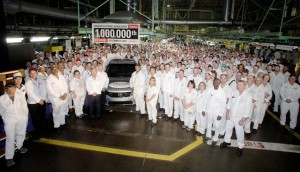Within two years, Honda will no longer be an “import” automaker. The Japanese-owned company says it expects to become a “net exporter” as it expands shipment of U.S.-made vehicles to South Korea and other parts of the world.
Ironically, at a time when the U.S. is putting a new emphasis on manufacturing – and the well-paying jobs it creates — foreign-owned automakers like Honda are taking a lead in shipping American-made vehicles to a growing list of overseas markets. Honda is already one of America’s largest automotive exporters, and expects to have shipped 100,000 vehicles to 40 countries by the end of 2012 from assembly plants in Ohio and other parts of the country.
And, at a ceremony marking the production of the 1 millionth American-made Honda bound for export, company officials said exports will grow larger than the number of vehicles Honda imports into the States by the end of 2014.
“Quality for the world, made in America, has been an important Honda commitment for the past 25 years,” Takanobu Ito, president & CEO of Honda Motor Co., Ltd., said in a video message to the gathering at the maker’s Marysville, Ohio assembly plant.
Marking its 30th anniversary this year, the Marysville factory was the first Japanese auto assembly plant in the U.S., and is now the anchor for an expanding Honda manufacturing network that sprawls across North America. The maker is currently adding a new facility in Mexico but has also been upgrading and expanding its U.S. production base – for a total investment of $2.2 billion. That will boost North American production capacity from 1.63 million to 1.92 million.
“In the coming years, we will take on the challenge of helping even more customers around the world enjoy Honda products made in the USA,” Ito promised.
In the early years, Japanese manufacturers fretted about whether American workers could match the quality of their Japanese counterparts. But that fear quickly faded away as survey data showed little, if any, difference. That not only encouraged the expansion of American production but offered an opportunity use those U.S. factories as a manufacturing base to supply other parts of the world.
Honda first began exporting vehicles from the U.S. in 1987, just five years after the Marysville factory opened. The first market was Taiwan, with Accords produced in Ohio. Today, the company produces a variety of Honda and Acura vehicles, as well as automotive components, for 40 different markets. It claims the value of its exports over the last 25 years has come to $22 billion.
Honda isn’t saying how many vehicles it expects to export by 2014 and beyond other than noting the total should “far surpass the company’s previous single-year export record of 105,511 vehicles set in 1994.”
The increase in U.S. production – and the concurrent bump up in exports – reflects not only confidence in American manufacturing but also the reality of global exchange rates. When the Marysville plant opened in 1982, the dollar bought as much as 271 yen. This year, the average has slipped below 80. That has made it increasingly difficult for makers like Honda to export from their home plants.
The March 2011 earthquake and tsunami that temporarily shuttered the Japanese auto industry further encouraged a shift abroad.
But Japanese makers aren’t alone. German brands BMW and Mercedes-Benz have also been expanding their U.S. and broader North American manufacturing bases. And exports have been growing, as well. The Mercedes plant near Tuscaloosa, Alabama supplies much of the world with the M-Class crossover, for example, and BMW has a number of export models rolling out of its factory in Spartanburg, South Carolina.

